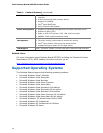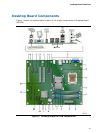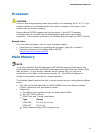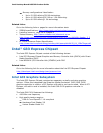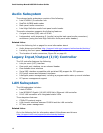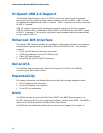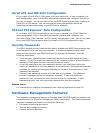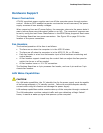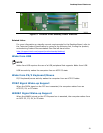Intel Desktop Board DG33FB Product Guide
18
Hi-Speed USB 2.0 Support
The Desktop Board supports up to 12 USB 2.0 ports (six ports routed to the back
panel and six ports routed to three internal headers) via the ICH9DH. USB 2.0 ports
are backward compatible with USB 1.1 devices. USB 1.1 devices will function normally
at USB 1.1 speeds.
USB 2.0 support requires both an operating system and drivers that fully support
USB 2.0 transfer rates. Disabling Hi-Speed USB in the BIOS reverts all USB 2.0 ports
to USB 1.1 operation. This may be required to accommodate operating systems that
do not support USB 2.0.
Enhanced IDE Interface
The board’s IDE interface handles the exchange of information between the processor
and peripheral devices such as hard disk drives and CD-ROM drives. The interface
supports:
• Up to two IDE devices (such as hard drives)
• ATAPI-style devices (such as CD-ROM drives)
• Older PIO Mode devices
• Ultra DMA-33 and ATA-66/100 protocols
Serial ATA
The Desktop Board supports four Serial ATA channels (3.0 Gb/s) via ICH9DH,
connecting one device per channel.
Expandability
For system expansion, the Desktop Board provides the following expansion slots:
• One PCI Express x16 connector
• Three PCI Express x1 connectors
• Three PCI bus connectors
BIOS
The BIOS provides the Power-On Self-Test (POST), the BIOS Setup program, the
PCI/PCI Express and IDE auto-configuration utilities, and the video BIOS. The BIOS is
stored in the Serial Peripheral Interface (SPI) Flash device.
The BIOS can be updated by following the instructions on page
59 in Chapter 3.



